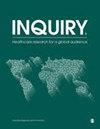Prevalence, Correlates, and Trends of Intimate Partner Violence Against Women in Cambodia: Findings From 2014 and 2021-22 Cross-Sectional Demographic and Health Surveys
IF 1.7
4区 医学
Q3 HEALTH CARE SCIENCES & SERVICES
Inquiry-The Journal of Health Care Organization Provision and Financing
Pub Date : 2024-04-20
DOI:10.1177/00469580241246465
引用次数: 0
Abstract
Intimate partner violence (IPV) is globally endemic and a gross violation of human rights, in addition to abuse of intimacy by some men against their female intimate partners. Based on literature review, attitudinal, socio-demographic, and experiential attributes of 15 to 49 year old ever partnered women in the heterosexual relationships were identified. This study used the anonymized 2020-21Cambodia Demographic and Health Survey (CDHS) data to compute the IPV prevalence and its correlates, in addition to computing the changes in IPV prevalence at the urban, rural, and at the national levels using data from the 2014 CDHS. Identified attitudinal, socio-demographic, and experiential attributes were used in the bivariate and multivariable analysis. Simple and multiple logistic regression models were used for computing the bivariate and multivariate associations with IPV; additionally, trend analysis was done to compute changes in IPV prevalence between the 2 surveys. Lifetime prevalence of IPV was 20.70%, while the most common subtype was emotional IPV at 18.70%. Ten out of 12 correlates studied were found to be statistically significantly associated with IPV in the bivariate analysis. These were added in the multivariable model and 7 were found to be statistically significantly associated with IPV. Which included educational attainment of women and their intimate partners, number of living children, women’s IPV acceptance, male partner’s alcohol use, knowledge of physical beating of mother by one’s father, and controlling behavior exercised by partner. During the intervening period between the 2 CDHSs, IPV and its subtypes were decreased in both urban and rural areas, as well as nationally. IPV decrease between the 2 DHSs and lower IPV rates in 2021-22 augur well for the health and human rights of Cambodian women. However, the ultimate target of eliminating IPV against women, will require measures that ensure economic and gender empowerment, and gender equality.柬埔寨亲密伴侣暴力侵害妇女行为的发生率、相关因素和趋势:2014 年和 2021-22 年横断面人口与健康调查的结果
亲密伴侣暴力(IPV)是一种全球流行的严重侵犯人权的行为,此外,一些男性还对其女性亲密伴侣实施亲密行为。根据文献综述,我们确定了 15 至 49 岁异性关系中曾经有伴侣的女性的态度、社会人口和经历特征。本研究使用匿名的 2020-21 年柬埔寨人口与健康调查(CDHS)数据计算 IPV 发生率及其相关因素,并使用 2014 年 CDHS 的数据计算城市、农村和全国 IPV 发生率的变化。双变量和多变量分析中使用了已识别的态度、社会人口和经历属性。简单和多元逻辑回归模型用于计算 IPV 的二元和多元关联;此外,还进行了趋势分析,以计算两次调查之间 IPV 发生率的变化。IPV的终生发生率为20.70%,而最常见的亚型为情感型IPV,占18.70%。在所研究的 12 个相关因素中,有 10 个在双变量分析中发现与 IPV 有显著的统计学关联。将这些因素加入多变量模型后,发现其中 7 个因素与 IPV 有明显的统计学相关性。这些因素包括妇女及其亲密伴侣的教育程度、在世子女数量、妇女对 IPV 的接受程度、男性伴侣酗酒情况、对父亲殴打母亲的了解程度以及伴侣的控制行为。在两次人口与健康调查之间的间隔期内,城市和农村地区以及全国的 IPV 及其子类型都有所减少。两次人口与健康调查之间的 IPV 下降以及 2021-22 年 IPV 发生率的降低,都是柬埔寨妇女健康和人权的好兆头。然而,要实现消除针对妇女的 IPV 这一最终目标,还需要采取措施确保经济赋权、性别赋权和性别平等。
本文章由计算机程序翻译,如有差异,请以英文原文为准。
求助全文
约1分钟内获得全文
求助全文
来源期刊
CiteScore
2.50
自引率
0.00%
发文量
192
审稿时长
>12 weeks
期刊介绍:
INQUIRY is a peer-reviewed open access journal whose msision is to to improve health by sharing research spanning health care, including public health, health services, and health policy.

 求助内容:
求助内容: 应助结果提醒方式:
应助结果提醒方式:


